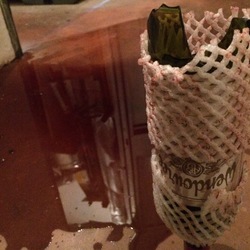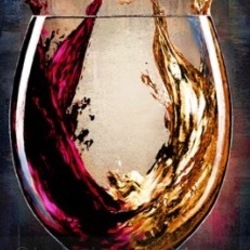Left Bank
Heitz Cellar
Martha's Vineyard Cabernet Sauvignon 1991
Château Latour
Premier Grand Cru Classé Pauillac Red Bordeaux Blend 1983
Château Latour is an iconic estate in the Pauillac commune on the left bank of Bordeaux, achieving coveted ‘First Growth’ status in the 1855 Bordeaux Classification.
The estate has roots dating back to the 14th century and derives its name ‘La Tour’ from a fortress tower built during the Hundred Years’ War, which no longer exists but is prominently featured on the label in recognition of its history.
We weren’t sure what to expect, as many have predicted these 1983s are likely past their prime, but this wine was a masterpiece. 🤩
It was medium garnet in color with expressive notes of cedar box, cigar, clove, peat, leather, forest floor, fig, prune, dried black cherry, plum, cassis, blackberry compote, cardamom, cinnamon, star anise, dried violet, potpourri, kalamata olive, pencil shavings, graphite, & bacon fat.
It had the most velvety, fine-grained tannins that washed across the palate with ease, with a gentle but notable acidity that maintained lift and balance. It was concentrated, complex, and had a long, elegant finish. — 2 months ago

Château Léoville-Las Cases
Grand Vin de Leoville du Marquis de las Cases Saint-Julien Red Bordeaux Blend 1997
Tipicity! You know it’s Bordeaux, and great, the moment you smell it. Yet this dark fruit, pencil lead one took me to the wrong bank. It felt fresh, and less dark. Blackberries and plums, for sure. A great wine. So young… — 4 months ago
Anderson's Conn Valley Vineyards
Right Bank Red Bordeaux Blend 2018
The reasonably-priced Right Bank is probably my favorite from the winery. For 2018, it’s a blend of 56% Cab Franc and 44% Merlot.
The perfumed nose offers lush dark cherry, plum, and violet aromas, layered with hints of tobacco, cocoa, and early autumn leaves. The palate is velvety yet structured, with bright acidity balancing ripe fruit and savory spice. Polished tannins lead to a lingering finish with notes of mocha and dried herbs. — a month ago
Château Lynch-Bages
Grand Cru Classé Pauillac Cabernet Sauvignon Blend 1989
Opened and decanted hours prior to dinner; enjoyed over the course of a couple hours. The 1989 appears a deep garnet color with a near opaque core; medium viscosity with moderate staining of the tears. On the nose, the wine is vinous with notes of tart, ripe, and dried fruits: cassis, blackberries, black cherry, black plum, tobacco, Poblano pepper, mixed dried flowers, some cocoa, pencil shavings, dried green herbs, a touch of leather, some organic and gravelly earth and fine warm spices. On the palate, the wine is dry with medium+ tannin (integrated) and medium+ acid. Confirming the notes from the nose. The finish is long. Fabulous stuff with plenty of fuel left in the tank. Drink now through 2039. — a month ago



Château Figeac
St. Émilion Red Bordeaux Blend 2024
97-98. Best wine tasted in the right bank.
Pure flowery and fruity aromas of incredible precision.
In the mouth it is simply perfect. Given the challenges of the vintage it is really incredible.
Technical yes, but not lacking personality.
A real great wine. — 3 months ago
Château Barde-Haut
Saint-Émilion Red Bordeaux Blend 2017
Super earthy at first, but with air the fruit/earth balance is equilibrating. Loads of irony/clay notes in the nose, with dark plummy fruit. Tannins are integrating but still present. This presents more like a 20th Century right bank wine than what is usual now, with fruit and softness but no overripeness and a nice sense of restraint. — 4 months ago
Château de Beaucastel
Châteauneuf-du-Pape Red Rhône Blend 2012
From 375ml.
A very good Rhone producer visited in 2015.
At pop & pour, the fruits almost had a mid berry bubble gum character. That toned down almost immediately. Fruits are ripe; blackberries, black raspberries, baked plums, raspberries, dark cherries, juicy strawberries, chocolate bar to fudge, grilled, smoked meats, black pepper, dark spice, nutmeg, clove, iron pan, black tea, a touch of rubber toy, slight tarriness, dry herbs, roasted chestnuts, tobacco leaf, dry crushed rocks, dry top soil, hints of mint, dark, red flowers, violet’s, nice acidity with a well balanced-structured, stiffly tensioned with a lush finish that lasts 90 seconds and lands on earthiness & spice.
Plenty of life left in this 2012, even in 375ml. — 14 days ago
Château Mouton Rothschild
Pauillac Red Bordeaux Blend 1966
From back when Mouton was still a Second Growth. Decanted prior to service; enjoyed over the course of several hours. This bottle of the 1966 pours a garnet color with significant rim variation; medium viscosity with light staining and signs of sediment. On the nose, the wine is vinous with notes of ripe and desiccated red and black fruits: cassis, blackberries, green pepper, tobacco, leather, old wood, organic earth and warm spices. On the palate, the wine is dry with medium tannin and medium acid. Confirming the notes from the nose. The finish is medium. This was a good showing for the ‘66 and certainly has life left in it however, there’s no need to hold out. Drink now. — a month ago
Château L'Evangile
Pomerol Red Bordeaux Blend 2006
Presented to me double-blind at Tasting Group. The wine pours a deep garnet color with a near opaque core and rust colored rim; medium+ viscosity with moderate staining of the tears and some signs of light sediment. On the nose, the wine is vinous with notes of ripe and drying fruits: lightly stewed blackberries, black cherry, plums, tobacco, dried green herbs, old fine wood, vanilla and warm spices. On the palate, the wine is dry with medium+ tannin and medium+ acid. Confirming the notes from the nose. The finish is long.
Initial conclusions: this could be Tempranillo, Malbec, Merlot (or based blend), or Zinfandel-based blend from Spain, Argentina, France or the United States. However, the staining was a bit much unless there was a lot of PS in the blend so I eliminated Zinfandel. I also didn’t think this was purple enough for Malbec. This left me with Tempranillo or Merlot and I felt that this leaned more towards its structure than fruit so I was leaning Spain or France with 15-20 years of age and from a solar vintage. Ultimately, I chose Tempranillo, from Spain, Rioja, Gran Reserva from 2006…from a quality producer like C.V.N.E. Yeah, I can see Pomerol. Shoot. This is stuff and ready to drink now and will drink well through 2032+. — 2 months ago













Shay A

Anytime an older Heitz Martha’s is open, it’s a treat. I’ve tried to acquire a few random bottles over the years and they have consistently impressed (‘78 and ‘01, specifically). My first early ‘90s vintage.
Quick double decant to simply get the wine off sediment as it wouldn’t be consumed from a decanter at the location I would be at.
In my experience, the distinct and typical eucalyptus notes jump right at pop, but this bottle was a little subdued early on. After an hour with the cork out, the eucalyptus, herbs, cedar and red fruit made their entrance. Compared to the ‘91 Hartwell I opened a few months ago, this was more elegant and less dense on the mid-palate. If not for the eucalyptus, I could see this being called left bank Bordeaux with 30yrs on it. Gained some darker red/underripe black fruit notes the longer it was open. Beautiful length at the finish. Bright acidity and tannin. Not getting better, but a wonderful drinking window to enjoy now. — 15 days ago